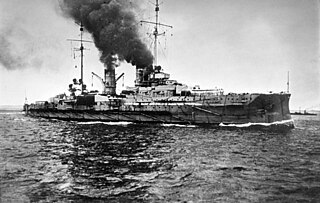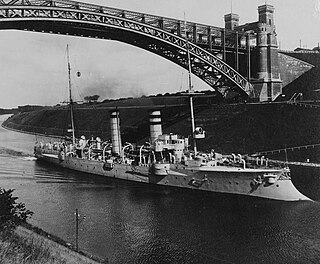
SMS Blücher was the last armored cruiser built by the German Empire. She was designed to match what German intelligence incorrectly believed to be the specifications of the British Invincible-class battlecruisers. Blücher was larger than preceding armored cruisers and carried more heavy guns, but was unable to match the size and armament of the battlecruisers which replaced armored cruisers in the British Royal Navy and German Imperial Navy. The ship was named after the Prussian Field Marshal Gebhard von Blücher, the commander of Prussian forces at the Battle of Waterloo in 1815.

SMS Hindenburg was a battlecruiser of the German Kaiserliche Marine, the third ship of the Derfflinger class, built to a slightly modified design. She carried the same battery of eight 30.5 cm (12 in) guns, but in improved turrets that allowed them to fire further. The ship was also slightly larger and faster than her two sister ships. She was named in honor of Field Marshal Paul von Hindenburg, the victor of the Battle of Tannenberg and the Battle of the Masurian Lakes, as well as Supreme Commander of the German armies from 1916. The ship was the last capital ship of any type built for the German navy during World War I.

SMS Moltke was the lead ship of the Moltke-class battlecruisers of the German Imperial Navy, named after the 19th-century German Field Marshal Helmuth von Moltke. Commissioned on 30 September 1911, the ship was the second battlecruiser of the Imperial Navy. Moltke, along with her sister ship Goeben, was an enlarged version of the previous German battlecruiser design, Von der Tann, with increased armor protection and two more main guns in an additional turret. Compared to her British rivals—the Indefatigable class—Moltke and her sister Goeben were significantly larger and better armored.

SMS Von der Tann was the first battlecruiser built for the German Kaiserliche Marine, as well as Germany's first major turbine-powered warship. At the time of her construction, Von der Tann was the fastest dreadnought-type warship afloat, capable of reaching speeds in excess of 27 knots. She was designed in response to the British Invincible class. While the German design had slightly lighter guns—28 cm (11 in), compared to the 30.5 cm (12 in) Mark X mounted on the British ships—Von der Tann was faster and significantly better-armored. She set the precedent of German battlecruisers carrying much heavier armor than their British equivalents, albeit at the cost of smaller guns.

SMS Cöln was a Kolberg-class light cruiser of the German Kaiserliche Marine during the First World War. She had three sister ships, SMS Kolberg, Mainz, and Augsburg. She was built by the Germaniawerft in Kiel; her hull was laid down in 1908 and she was launched in June 1909. Cöln was commissioned into the High Seas Fleet in June 1911. She was armed with a main battery of twelve 10.5 cm SK L/45 guns and had a top speed of 25.5 kn. After her commissioning, she served with the II Scouting Group, part of the reconnaissance forces of the High Seas Fleet.

SMS Pillau was a light cruiser of the Imperial German Navy. The ship, originally ordered in 1913 by the Russian navy under the name Maraviev Amurskyy, was launched in April 1914 at the Schichau-Werke shipyard in Danzig. However, due to the outbreak of World War I in August 1914, the incomplete ship was confiscated by Germany and renamed SMS Pillau for the East Prussian port of Pillau. Pillau was commissioned into the German Navy in December 1914. She was armed with a main battery of eight 15 cm SK L/45 (5.9-inch) guns and had a top speed of 27.5 kn. One sister ship was built, Elbing.

SMS Frauenlob was the eighth member of the ten-ship Gazelle class of light cruisers that were built for the German Kaiserliche Marine in the late 1890s and early 1900s. The Gazelle class was the culmination of earlier unprotected cruiser and aviso designs, combining the best aspects of both types in what became the progenitor of all future light cruisers of the Imperial fleet. Built to be able to serve with the main German fleet and as a colonial cruiser, she was armed with a battery of ten 10.5 cm (4.1 in) guns and a top speed of 21.5 knots. Frauenlob was a modified version of the basic Gazelle design, with improved armor and additional coal storage for a longer cruising range.

SMS Frankfurt was a light cruiser of the Wiesbaden class built by the German Kaiserliche Marine. She had one sister ship, SMS Wiesbaden; the ships were very similar to the previous Karlsruhe-class cruisers. The ship was laid down in 1913, launched in March 1915, and completed by August 1915. Armed with eight 15 cm SK L/45 guns, Frankfurt had a top speed of 27.5 knots and displaced 6,601 t at full load.

SMS Strassburg was a light cruiser of the Magdeburg class in the German Kaiserliche Marine. Her class included three other ships: Magdeburg, Breslau, and Stralsund. Strassburg was built at the Kaiserliche Werft shipyard in Wilhelmshaven from 1910 to October 1912, when she was commissioned into the High Seas Fleet. The ship was armed with a main battery of twelve 10.5 cm (4.1 in) SK L/45 guns and had a top speed of 27.5 knots.

SMS Stettin was a Königsberg-class light cruiser of the Kaiserliche Marine. She had three sister ships: Königsberg, Nürnberg, and Stuttgart. Laid down at AG Vulcan Stettin shipyard in 1906, Stettin was launched in March 1907 and commissioned into the High Seas Fleet seven months later in October. Like her sisters, Stettin was armed with a main battery of ten 10.5 cm (4.1 in) guns and a pair of 45 cm (18 in) torpedo tubes, and was capable of a top speed in excess of 25 knots.

The Wiesbaden class of light cruisers was a class of ships built by the German Kaiserliche Marine shortly before the outbreak of World War I. Two ships were built in this class, Wiesbaden and Frankfurt. They were very similar to the preceding design, the Graudenz class, though they were armed with eight 15 cm SK L/45 guns instead of the twelve 10.5 cm SK L/45 guns on the earlier vessels. The ships had a top speed of 27.5 knots.

The Magdeburg class of light cruisers was a group of four ships built for the Imperial German Navy. The class comprised SMS Magdeburg, the lead ship, Breslau, Strassburg, and Stralsund. All four ships were laid down in 1910 and were completed by the end of 1912. They were armed with a main battery of twelve 10.5 cm guns, though over the course of their careers, Breslau, Strassburg, and Stralsund were rearmed with more powerful 15 cm guns. They displaced 4,570 t at full load and were rated at a top speed of 27.5 knots, though all four vessels exceeded that figure on trials.

The Graudenz class of light cruisers was a class of two ships built for the Imperial German Navy. The class comprised SMS Graudenz and SMS Regensburg. The ships both were laid down in 1912, launched in October 1913 and April 1914 and commissioned in August 1914 and January 1915, respectively. They were armed with a main battery of twelve 10.5 cm (4.1 in) guns, though over the course of their careers, they were rearmed with seven more powerful 15 cm (5.9 in) guns. They displaced 6,382 t at full load and were rated at a top speed of 27.5 knots

SMS Graudenz was the lead ship of her class of light cruisers. She had one sister ship, SMS Regensburg. The ship was built by the German Kaiserliche Marine in the Kaiserliche Werft shipyard in Kiel, laid down in 1912 and commissioned into the High Seas Fleet in August 1914, days after the outbreak of World War I. She was named for the then-German town of Graudenz. The ship was armed with a main battery of twelve 10.5 cm SK L/45 guns and had a top speed of 27.5 knots.

SMS Regensburg was a light cruiser of the Graudenz class built by the German Kaiserliche Marine. She had one sister ship, SMS Graudenz. The ship was built by the AG Weser shipyard in Bremen, laid down in 1912, launched in April 1914, and commissioned into the High Seas Fleet in January 1915. She was named for the German town of Regensburg. The ship was armed with a main battery of twelve 10.5 cm SK L/45 guns and had a top speed of 27.5 knots, though in 1917 she was rearmed with seven 15 cm SK L/45 guns.
SMS Stuttgart was a Königsberg-class light cruiser of the Kaiserliche Marine, named after the city of Stuttgart. She had three sister ships: Königsberg, Nürnberg, and Stettin. Stuttgart was laid down at the Imperial Dockyard in Danzig in 1905, launched in September 1906, and commissioned in February 1908. Like her sisters, Stettin was armed with a main battery of ten 10.5 cm (4.1 in) guns and a pair of 45 cm (18 in) torpedo tubes, and was capable of a top speed in excess of 25 knots.















